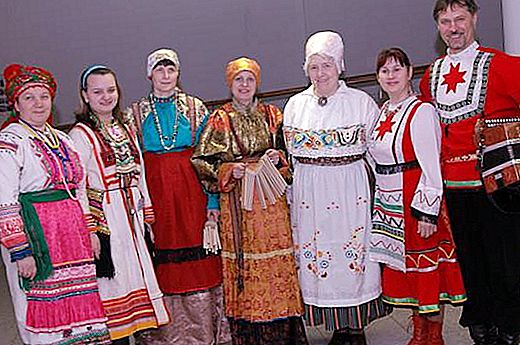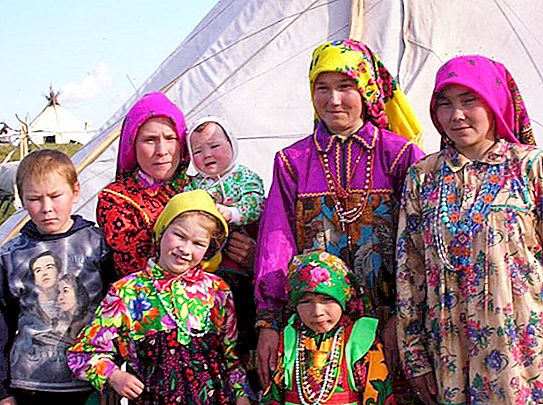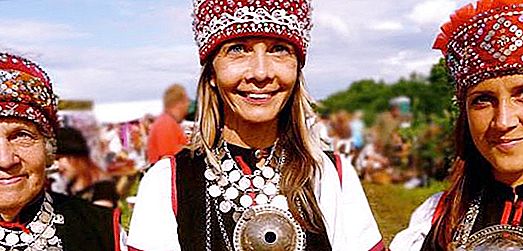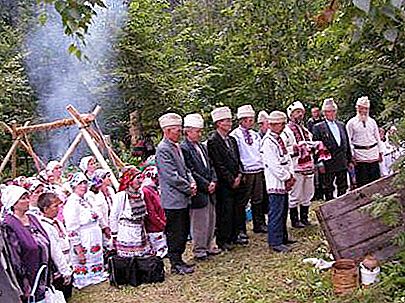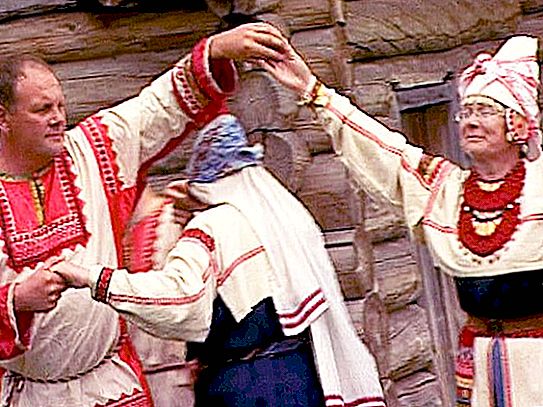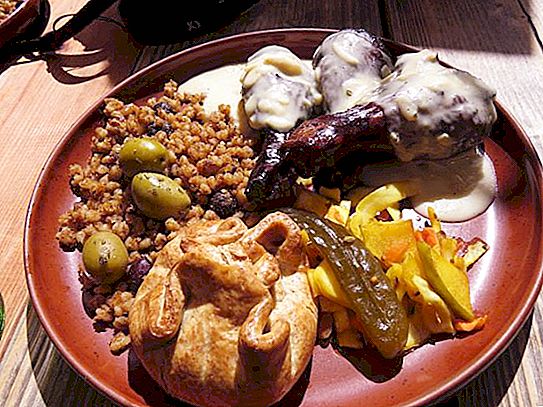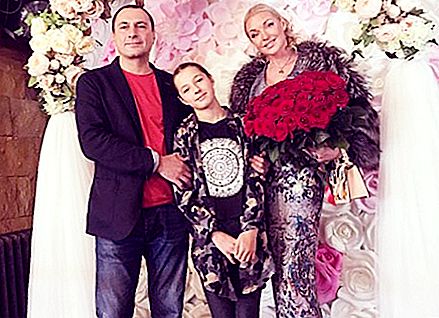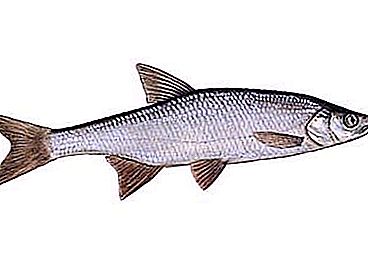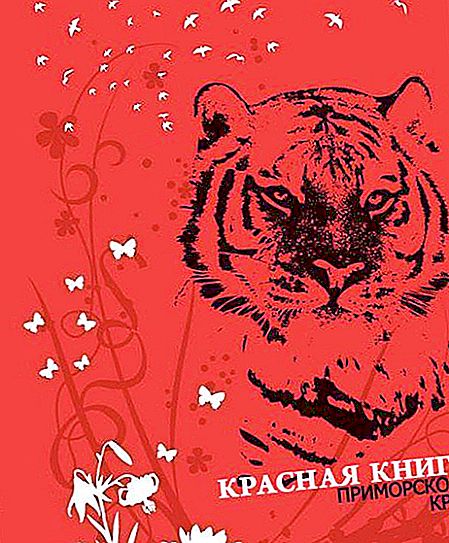Finno-Ugric languages are related to modern Finnish and Hungarian. The peoples speaking them make up the Finno-Ugric ethnolinguistic group. Their origin, territory of settlement, community and difference in external features, culture, religion and traditions are subjects of global research in the field of history, anthropology, geography, linguistics and a number of other sciences. This review article will try to briefly cover this topic.
Peoples belonging to the Finno-Ugric ethnic language group
Based on the degree of proximity of languages, researchers divide the Finno-Ugric peoples into five subgroups.
The basis of the first, Baltic-Finnish, is made up of Finns and Estonians - peoples with their own states. They also live in Russia. Setu, a small group of Estonians, is settled in the Pskov region. The most numerous of the Baltic-Finnish peoples of Russia are Karelians. In everyday life they use three autochthonous dialects, while Finnish is considered the literary language in them. In addition, the Vepsians and Izhorsky people belong to the same subgroup - small nations that have preserved their languages, as well as Vod (there are less than a hundred of them left, their own language has been lost) and Livs.
The second is the Sami (or Lopar) subgroup. The bulk of the peoples who gave it a name are settled in Scandinavia. In Russia, the Sami live on the Kola Peninsula. Researchers suggest that in ancient times these peoples occupied a larger territory, but were subsequently pushed north. Then their own language was replaced by one of the Finnish dialects.
The third subgroup comprising the Finno-Ugric peoples - the Volga-Finnish - includes the Mari and the Mordovians. Mari - the bulk of the population of the Mari El Republic, they also live in Bashkortostan, Tatarstan, Udmurtia and a number of other Russian regions. They distinguish two literary languages (with which, however, not all researchers agree). Mordva - the indigenous population of the Republic of Mordovia; at the same time, a significant part of the Mordvinians is settled throughout Russia. This people consists of two ethnographic groups, each with its own literary written language.
The fourth subgroup is called Perm. It includes Komi, Komi-Permyaks, as well as Udmurts. Even before October 1917, in terms of literacy (though in Russian), Komi approached the most educated peoples of Russia - Jews and Russian Germans. As for the Udmurts, their dialect is preserved for the most part in the villages of the Udmurt Republic. Residents of cities, as a rule, forget both the indigenous language and customs.
The fifth, Ugric, subgroup includes Hungarians, Khanty and Mansi. Although the lower reaches of the Ob and the northern Urals separate many kilometers from the Hungarian state on the Danube, these peoples are actually the closest relatives. Khanty and Mansi belong to the small peoples of the North.
The disappeared Finno-Ugric tribes
The Finno-Ugric peoples also included tribes, mentions of which are currently preserved only in chronicles. So, the people of Meria lived in the interfluve of the Volga and Oka in the first millennium AD - there is a theory that it subsequently merged with the Eastern Slavs.
The same thing happened with Murom. This is an even more ancient people of the Finno-Ugric ethnolinguistic group, who once inhabited the Oka basin.
Researchers who have long disappeared Finnish tribes living along the Onega and Northern Dvina rivers are called a miracle (according to one hypothesis, they were the ancestors of modern Estonians).
Commonality of languages and culture
Having declared Finno-Ugric languages as a single group, researchers emphasize this community as the main factor uniting the peoples speaking them. However, the Uralic ethnic groups, despite the similarities in the structure of their languages, still do not always understand each other. Thus, the Finn will certainly be able to communicate with the Estonian, the Erzyan with the Mokshanin, and the Udmurt with the Komi. However, the peoples of this group, geographically distant from each other, must make a lot of efforts to identify common features in their languages that would help them to have a conversation.
The linguistic kinship of the Finno-Ugric peoples is primarily evident in the similarity of linguistic constructions. This significantly affects the formation of thinking and worldview of peoples. Despite the difference in cultures, this circumstance contributes to the emergence of mutual understanding between these ethnic groups.
At the same time, a peculiar psychology, caused by the thought process in these languages, enriches universal culture with their unique vision of the world. So, unlike the Indo-European, the representative of the Finno-Ugric people is inclined to treat nature with exceptional respect. The Finno-Ugric culture also greatly contributed to the desire of these peoples to peacefully adapt to their neighbors - as a rule, they preferred not to fight, but to migrate, preserving their identity.
Also a characteristic feature of the peoples of this group is openness to ethnocultural interchange. In their search for ways to strengthen relations with kindred nationalities, they maintain cultural contacts with all those around them. Basically, the Finno-Ugrians managed to preserve their languages, the main cultural elements. The connection with ethnic traditions in this area can be traced in their national songs, dances, music, traditional dishes, clothing. Also, many elements of their ancient rites have survived to our days: wedding, funeral, funeral.
A brief history of the Finno-Ugric peoples
The origin and early history of the Finno-Ugric peoples to this day remain the subject of scientific discussion. Among researchers, the most common opinion is that in ancient times there was a single group of people who spoke the common Finno-Ugric parent language. The ancestors of the current Finno-Ugric peoples until the end of the third millennium BC. e. maintained relative unity. They were settled in the Urals and the western Urals, and possibly also in some areas adjacent to them.
In that era, called the Finno-Ugric, their tribes were in contact with the Indo-Iranians, which was reflected in myths and languages. Between the third and second millennia BC e. Ugric and Finno-Permian branches separated from each other. Among the peoples of the latter, settled in the western direction, independent subgroups of languages (Baltic-Finnish, Volga-Finnish, Perm) gradually stood out and separated. As a result of the transition of the autochthonous population of the Far North to one of the Finno-Ugric dialects, Sami were formed.
The Ugric group of languages fell apart by the middle of the 1st millennium BC. e. The separation of the Baltic-Finnish occurred at the beginning of our era. Perm lasted a little longer - until the eighth century. The contacts of the Finno-Ugric tribes with the Baltic, Iranian, Slavic, Turkic, Germanic peoples played an important role in the separate development of these languages.
Resettlement area
Finno-Ugric peoples today mainly live in North-Western Europe. Geographically, they are settled on a vast territory from Scandinavia to the Urals, Volga-Kama, Lower and Middle Pritobolie. Hungarians are the only people of the Finno-Ugric ethno-linguistic group who formed their state aside from other related tribes - in the Carpathian-Danube region.
The number of Finno-Ugric peoples
The total number of peoples speaking the Uralic languages (these include Finno-Ugric together with Samoyedic) is 23-24 million people. The most numerous representatives are Hungarians. There are more than 15 million people in the world. They are followed by Finns and Estonians (5 and 1 million people, respectively). Most other Finno-Ugric ethnic groups live in modern Russia.
Finno-Ugric ethnic groups in Russia
Russian immigrants massively rushed to the land of the Finno-Ugric peoples in the XVI-XVIII centuries. Most often, the process of their resettlement in these parts took place peacefully, however, some indigenous peoples (for example, the Mari) long and fiercely resisted the accession of their land to the Russian state.
The Christian religion, writing, urban culture, introduced by the Russians, eventually began to supplant local beliefs and dialects. People moved to cities, moved to Siberian and Altai lands - to where Russian was the main and common language. However, he (especially his northern dialect) absorbed many Finno-Ugric words - this is most noticeable in the field of toponyms and names of natural phenomena.
In some places, the Finno-Ugric peoples of Russia mingled with the Turks, adopting Islam. However, a significant part of them was still assimilated by the Russians. Therefore, these peoples do not constitute a majority anywhere - even in those republics that bear their name.
Nevertheless, according to the census in 2002, very large Finno-Ugric groups are found in Russia. These are Mordovians (843 thousand people), Udmurts (almost 637 thousand), Mari (604 thousand), Komi-Zyryans (293 thousand), Komi-Permyaks (125 thousand), Karelians (93 thousand). The number of some peoples does not exceed thirty thousand people: Khanty, Mansi, Veps. Izhorians count 327 people, and the Vod people - only 73 people. Hungarians, Finns, Estonians, and Sami also live in Russia.
The development of Finno-Ugric culture in Russia
In total, sixteen Finno-Ugric peoples live in Russia. Five of them have their own national-state formations, and two - national-territorial. Others are dispersed throughout the country.
Considerable attention is paid in Russia to the preservation of the original cultural traditions of the ethnic groups inhabiting it. Programs are being developed at the national and local levels with the support of which the culture of the Finno-Ugric peoples, their customs and dialects are studied.
So, Sami, Khanty, Mansi are taught in elementary grades, and Komi, Mari, Udmurt, Mordovian languages are taught in secondary schools in those regions where large groups of relevant ethnic groups live. There are special laws on culture and languages (Mari El, Komi). So, in the Republic of Karelia there is a law on education that enshrines the right of Vepsians and Karelians to study in their native language. The priority of developing the cultural traditions of these peoples is determined by the Law on Culture.
Also in the republics of Mari El, Udmurtia, Komi, Mordovia, in the Khanty-Mansi Autonomous Okrug there are own concepts and programs of national development. The Fund for the Development of Cultures of Finno-Ugric Peoples (in the territory of the Mari El Republic) has been created and operates.
Finno-Ugric peoples: appearance
The ancestors of the current Finno-Ugric peoples occurred as a result of the mixing of the Paleo-European and Paleo-Asian tribes. Therefore, the appearance of all the peoples of this group contains both Caucasoid and Mongoloid features. Some scholars even put forward the theory of the existence of an independent race - the Ural, which is "intermediate" between Europeans and Asians, but this version has few supporters.
The Finno-Ugric peoples are heterogeneous anthropologically. However, the characteristic "Ural" features in one way or another possesses any representative of the Finno-Ugric people. This is, as a rule, medium height, very fair hair color, "snub-nosed" nose, broad face, thin beard. But these features manifest themselves in different ways. So, Erzya Mordvins are tall, owners of blond hair and blue eyes. Mordvins-moksha - on the contrary, are shorter, broad-cheeked, with darker hair. Udmurts and Mari often have characteristic "Mongolian" eyes with a special fold at the inner corner of the eye - an epicanthus, very broad faces, a fluid beard. But at the same time, their hair is usually light and red, and their eyes are blue or gray, which is typical for Europeans, but not Mongoloids. The "Mongolian fold" is also found among Izhora, Vodi, Karelians and even Estonians. Komi look different. Where there are mixed marriages with the Nenets, representatives of this people are braces and black hairs. Other Komi, by contrast, are more likely to resemble the Scandinavians, but more broadly.
Finno-Ugric traditional cuisine in Russia
Most of the dishes of traditional cuisines of the Finno-Ugric population of the Urals and Trans-Urals, in fact, were not preserved or were significantly distorted. However, ethnographers manage to trace some general patterns.
The main food of the Finno-Ugric peoples was fish. It was not only processed in different ways (fried, dried, cooked, boiled, dried, eaten raw), but each species was prepared in its own way, which would better convey taste.
Before the appearance of firearms, the main way of hunting in the forest was snares. Caught mainly forest birds (black grouse, wood grouse) and small animals, mainly hare. Stewed meat and poultry, cooked and baked, much less often - fried.
From vegetables, turnip and radish were used, from spicy herbs - gruhu, hogweed, horseradish, onion, young dwarf growing in the forest. Western Finno-Ugric peoples practically did not consume mushrooms; at the same time, for the eastern, they constituted a significant part of the diet. The oldest types of grain known to these peoples are barley and wheat (spelled). From them cooked cereals, hot jelly, as well as a filling for homemade sausages.
The modern culinary repertoire of the Finno-Ugric peoples contains very few national features, since it was strongly influenced by Russian, Bashkir, Tatar, Chuvash and other cuisines. However, almost every nation has preserved one or two traditional, ritual or festive dishes that have survived to this day. In sum, they allow you to make a general idea of Finno-Ugric culinary.
